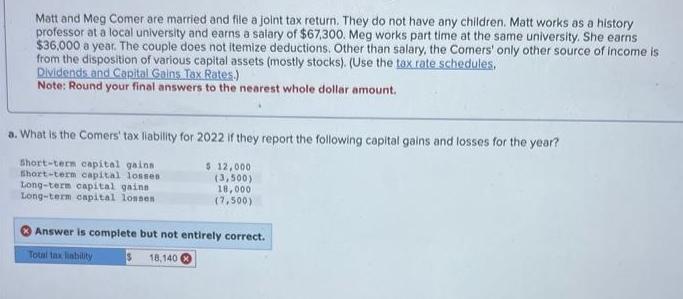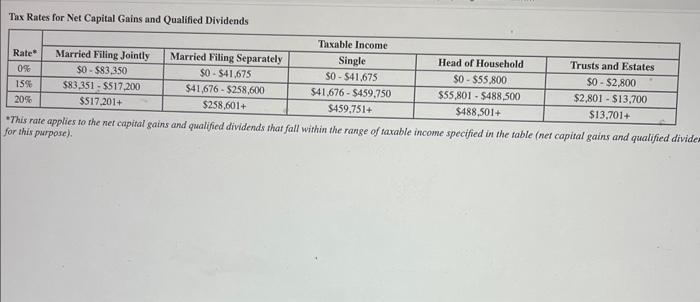Matt and Meg Comer are married and file a joint tax return. They do not have any children. Matt works as a history professor




Matt and Meg Comer are married and file a joint tax return. They do not have any children. Matt works as a history professor at a local university and earns a salary of $67,300. Meg works part time at the same university. She earns $36,000 a year. The couple does not itemize deductions. Other than salary, the Comers' only other source of income is from the disposition of various capital assets (mostly stocks). (Use the tax rate schedules. Dividends and Capital Gains Tax Rates.) Note: Round your final answers to the nearest whole dollar amount. a. What is the Comers' tax liability for 2022 if they report the following capital gains and losses for the year? $ 12,000 Short-term capital gains. Short-term capital losses Long-term capital gains (3,500) 18,000 Long-term capital lossen (7,500) Answer is complete but not entirely correct. Total tax liability 18,140 b. What is the Comers' tax liability for 2022 if they report the following capital gains and losses for the year? Short-term capital gains Short-term capital losses i Long-term capital gains Long-term capital losses. Total tax liability $1,500 0 14,500 (11,500) Tax Rates for Net Capital Gains and Qualified Dividends Rate 0% 15% 20% Married Filing Jointly $0-$83,350 $83,351-$517,200 $517,201+ Married Filing Separately $0-$41,675 $41,676-$258,600 $258,601+ Taxable Income Single $0-$41,675 $41,676-$459,750 $459,751+ Head of Household $0-$55,800 $55,801-$488,500 $488,501+ Trusts and Estates $0-$2,800 $2,801-$13,700 $13,701+ *This rate applies to the net capital gains and qualified dividends that fall within the range of taxable income specified in the table (net capital gains and qualified divide for this purpose). Schedule Y-1-Married Filing Jointly or Qualifying Widow(er) If taxable income is over: But not over: 0. $ $ 20,550 $ 83,550 $ 178,150 $340,100 $ 431,900 $ 647,850 The tax is: $ 20,550 10% of taxable income $ 83,550 $2,055 plus 12% of the excess over $20,550 $ 178,150 $9,615 plus 22% of the excess over $83,550 $340,100 $30,427 plus 24% of the excess over $178,150 $431,900 $69,295 plus 32% of the excess over $340,100 $647,850 $98,671 plus 35% of the excess over $431,900 $174,253.50 plus 37% of the excess over $647,850 -
Step by Step Solution
There are 3 Steps involved in it
Step: 1

See step-by-step solutions with expert insights and AI powered tools for academic success
Step: 2

Step: 3

Ace Your Homework with AI
Get the answers you need in no time with our AI-driven, step-by-step assistance
Get Started


